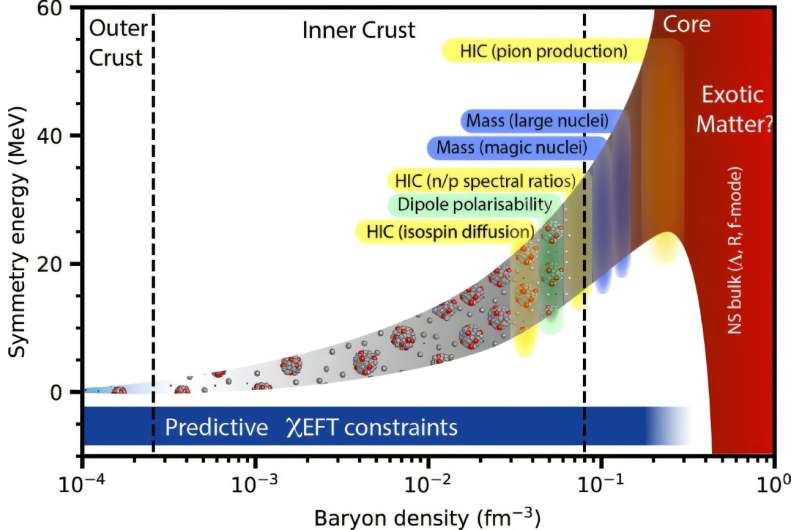The study of ‘starquakes’ (like earthquakes, but in stars) promises to give us important new insights into the properties of neutron stars (the collapsed remnants of massive stars), according to new research led by the University of Bath in the UK.
Such explorations have the potential to challenge our current approaches to studying nuclear matter, with important impacts for the future of both nuclear physics and astronomy. Longer term, there may also be implications in the fields of health, security and energy.
The value of studying asteroseismology—as these vibrations and flares are known—has emerged from research carried out by an international team of physicists that includes Dr. David Tsang and Dr. Duncan Neill from the Department of Physics at Bath, along with colleagues from Texas A&M and the University of Ohio.
The team’s study, published in Physical Review C, examines how asteroseismology in neutron stars can test predictions about nuclear matter.
The scientists found that measuring these quakes from Earth using powerful telescopes provides detailed information about what is happening inside a neutron star. This helps test and validate a theory called Chiral Effective Field Theory, which in turn is key to improving our understanding of the universe and advancing the way we live on our planet.
A key objective for today’s nuclear scientists is to deepen their understanding of the properties and behaviors of nuclear matter, such as protons and neutrons. This refined understanding is crucial for enhancing their knowledge of the universe’s basic building blocks and the forces that govern them.
“Our findings promise to add to, or change, the tools used by nuclear physicists, and bring astronomy and nuclear physics closer together,” said lead author, postdoctoral researcher Dr. Neill.
“These results make clear the significance that astronomical observations could have for nuclear physics, helping to connect fields of research that have traditionally been separate.”
By aiding the development of nuclear theory, the findings from this study contribute to efforts that may eventually yield benefits for health, security, and energy solutions in the following ways:
- Health: By enhancing techniques like radiation therapy and diagnostic imaging
- National Security: By ensuring the safe and secure maintenance and development of nuclear weapons
- Nuclear Energy: By helping with the development of safe and efficient nuclear energy, leading to improved nuclear reactors and potentially new energy sources
The significance of starquakes in neutron stars
Neutron stars are the dead remnants of massive stars that have burnt through all of their fuel. These objects collapse under their own gravity, becoming compact objects containing the densest matter in the universe.
These extreme conditions mean that the properties of matter inside them may provide key information about the fundamental nature of matter that cannot be obtained by studying matter in Earth-bound experiments.
At present, one of the most popular techniques for modeling nuclear matter in extreme conditions is a method called “Chiral Effective Field Theory.” As with any theory, it is important to test its predictions to check that it is consistent with real physics.
However, accurately measuring neutron stars, which are incredibly far away, is very challenging. Because of these challenges, scientists often focus on studying their basic, large-scale characteristics rather than the finer details. As a result, it’s hard to thoroughly test specific scientific theories about neutron stars.
“We propose that, in the near future, asteroseismology could be used to obtain granular detail about matter inside neutron stars, and thus test theories like Chiral Effective Field Theory,” said Dr. David Tsang, co-author of the study.
Duncan Neill added, “The asteroseismic techniques we propose have the advantage of using instruments already in operation, giving new applications to existing telescopes and expanding the tools of nuclear physics without requiring expensive new developments.
“As this work develops, we may find that we are able to use asteroseismology to pinpoint properties of matter at various densities within neutron stars, allowing astronomy to lead the way in guiding the development of new nuclear physics techniques. We hope to expand our research in asteroseismology at Bath, seeing just how much it could tell us.”
More information:
Duncan Neill et al, Resonant shattering flares as asteroseismic tests of chiral effective field theory, Physical Review C (2025). DOI: 10.1103/PhysRevC.111.015809
Provided by
University of Bath
Citation:
By studying neutron ‘starquakes,’ scientists hope to transform their understanding of nuclear matter (2025, February 5)
retrieved 5 February 2025
from https://phys.org/news/2025-02-neutron-starquakes-scientists-nuclear.html
This document is subject to copyright. Apart from any fair dealing for the purpose of private study or research, no
part may be reproduced without the written permission. The content is provided for information purposes only.

